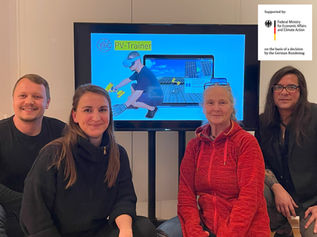
Digital hands-on training on the web with Virtual Reality for the photovoltaic industry
Because the energy transition
needs skilled professionals.
Version: Prototype
Compatibility: Oculus Quest
Languages: English | Spanish | German
Empowerd to evolve.
We are funded in 2025 for a feasibility project to transform the 'PV-Trainer' prototype into a scalable business model.
Our goal is to develop a market-driven solution backed by expert insights. Supported by the German Ministry for Economic Affairs and Climate Action, this feasibility study aims to shape a sustainable business model for lasting impact in solar education and beyond.


Join our survey now!
We’re building something great — and we’d love to hear from you! Take some minutes to answer a few quick questions and help shape the future with us.
Cooperation Partners
After years of collaboration and the groundwork laid with previous partners, we are joining forces once again. Together, we’re taking the next step by developing innovative training solutions with WebXR technology to set new standards for the photovoltaic industry and accelerate the energy transition.


RESEARCH PARTNER
Deutsche Gesellschaft für Sonnenenergie e.V.
The German Solar Energy Society (DGS) advances solar technology through innovative projects, professional training, and expert services. With decades of experience, the DGS has trained over 7,000 professionals and delivered globally trusted assessments. Through research, collaboration, and knowledge-sharing, the DGS drives the energy transition worldwide.
dgs-berlin.de

INDUSTRIAL PARTNER
Invisible Room GmbH & Co. KG
The Berlin-based company specializing in the conception, design, and development of digital solutions for the web.
Guided by the principle, "We give ideas digital spaces that inspire, convey knowledge, and open new doors," Invisible Room delivers projects that redefine how we experience and interact with threedimensional knowledge in the digital world.
Our mission
Tackling rising expansion targets and the untapped potential of solar capacity in the global net-zero scenario – achievable only through the training of skilled professionals.

Source: Solar capacity in the global net-zero scenario, IEA

The prototype
The prototype was developed in Unity 3D for the Oculus Quest, with the primary goal of validating the effectiveness of digital, hands-on training in photovoltaic assembly.
The development of the prototype was made possible through the collaboration of



.jpg)

Testing scope of the prototype
The prototype includes guided tutorials and one step-by-step structured courses with additional learning material such as written explanations, videos and graphics.
Insights and results of the user tests
Using VR training to complement assembly courses for the installation of solar panels offers numerous benefits, both for the training institution and the learners.
Practical and interactive learning
The training provides hands-on, practical experience in 3D, enhancing learning effectiveness and engagement through interactivity.
01
Repeatable learning-by-doing
Learners can repeatedly practice at their own pace, reinforcing skills through repetition and spatial learning.
02
Risk-free mistakes
Virtual environments allow learners to make mistakes without real-world consequences, fostering confidence and deeper understanding.
03
Flexible and cost-effective training
VR training offers flexibility in time and location, requiring only a VR headset, making it cost-effective and eliminating the logistical challenges of on-site training with physical test roofs.
04
Quantifiable learning outcomes
Gamification and data analysis enhance motivation and track progress, providing measurable learning success.
05
Career pathway
Beyond targeted courses, VR training can introduce new learners to solar panel installation and support recruitment efforts for skilled professionals.
06
Potentials for further development with WebXR
WebXR enables training directly in a browser, removing the need for dedicated apps and specific hardware. It works across devices like VR headsets, tablets, or desktops via a simple link, making access easier, more affordable, and widely accessible.
Broader accessibility
Expanding beyond exclusive reliance on VR headsets by integrating WebXR can make training more accessible, reaching a wider audience with minimal barriers.
01
Simplified deployment processes
Enhancing the application distribution system offers the potential to streamline accessibility, making it easier for institutions and learners to adopt WebXR trainings.
02
Optimized content scalability
By creating efficient tools and workflows for content updates, WebXR training can be rapidly scaled and adapted to meet evolving needs, ensuring long-term relevance and flexibility.
03
Are you part of the solar energy, finance, legal or education sector?
In Q1 and Q2 of 2025, we are conducting our feasibility study with the goal of developing a business model – and these are the building blocks we’re working on. We look forward to exchanging insights with professionals in these fields.












